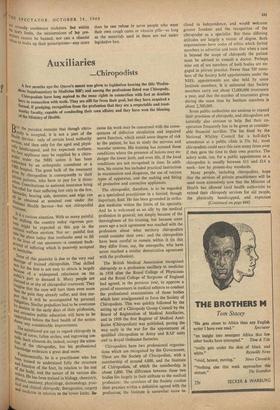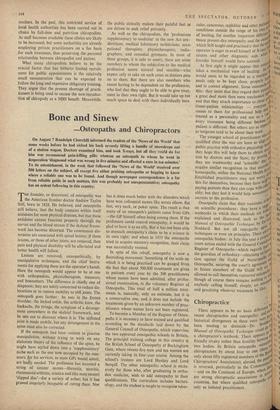What many chiropodists believe to be the crucial factor that
has hitherto limited recruit- ment for public appointments is the relatively small remuneration that can be expected to follow the long and expensive obligatory training. They argue that the present shortage of practi- tioners is being used to excuse the non-introduc- tion of chiropody as a NHS benefit. Meanwhile,
Bone and Sinew
MHE founder, or discoverer, of osteopathy was 1 the American frontier doctor Andrew Taylor Still, born in 1828. He believed, and osteopaths still believe, that the body contains within itself antidotes for most physical diseases, but that theie antidotes cannot function properly through the nerves and the blood stream if the skeletal frame- work has become distorted. The commonest dis- tortions are associated with spinal lesions; if these lesions, or those of other joints, are removed, then pain and physical disability will be alleviated and better health will follow.
Lesions are removed, osteopathically, by manipulative techniques, and the chief instru- ments for applying these are the operator's hands. Here the osteopath would appear to be at one with orthopedists, physiotherapists, masseurs, and bonesetters. The difference is chiefly one of diagnosis; they are solely concerned to reduce dis- locations or to restore mobility to stiff joints. The osteopath goes farther: he sees in the frozen shoulder, the locked ankle, the arthritic knee, the backache, the twinge, the symptom of a derange- ment somewhere in the skeletal framework, and he sets out to discover where it is. The stiffened joint is made mobile, but any derangement in the spine must also be corrected.
If the osteopath had been content to practise manipulation, without trying to work on any elaborate theory of the influence of the spine, he might have sejtled down into a 'supplementary' niche such as the one now occupied by the mas- seurs; for his services, as most GPs would admit, are badly needed. The profession has invented a string of sinister names—fibrositis, neuritis, rheumatoid arthritis, sciatica and (the most recent) 'slipped disc'—for a variety of aches; but it has proved singularly incapable of curing them. Nor
—Osteopaths and Chiropractors
On August 7 Randolph Churchill informed the readers of the 'News of the World' that some weeks before he had ricked his back severely lifting a bundle of snowdrops out of a station wagon. Doctors examined him, and took X-rays, but all they could do for him was recommend pain-killing pills; whereas an osteopath to whom he went in desperation 'diagnosed what was wrong in five minutes and effected a cure in ten minutes' To its astonishment, in the week that followed the 'News of the World' received over 500 letters on the subject, all except five either praising osteopaths or begging to know where a reliable one was to be found. And though newspaper correspondence is a far from reliable guide in such matters, this was probably not unrepresentative; osteopathy has an ardent following in this country.
has it done much better with the disorders which have won colloquial names like tennis elbow, flat feet, wry neck, or poker spine. The result is that many of an osteopath's patients come from GPs —the GP himself often being among them. If the profession could control osteopathy, it would be glad to have it as an ally. But it has not been able to stomach osteopathy's claim to be a science in its own right; and when in 1935 the osteopaths tried to acquire statutory recognition, their claim was successfully resisted.
In spite of this rebuff, osteopathy is now a flourishing movement:Something of the scale on which it is being practised can be gauged from the fact that about 500,000 treatments are given to patients every year by the 300 practitioners whose names have been admitted, after profes- sional examination, to the voluntary Register of Osteopaths. This total of half a million treat- ments is, naturally, only an estimate, but it is a conservative one, and it does not include the treatments given by an unknown number of prac- titioners whose names have not been registered.
To become a Member of the Register of Osteo- paths it is necessary to have trained and qualified according to the standards laid down by the General Council of Osteopaths, which supervises the two approved osteopathic schools in Britain. The principal training college in this country is the British School of Osteopathy at Buckingham Gate, where twenty-five men and ten women are currently taking its four-year course. Among the school's trustees are Lord Hankey and Lord Sempill. The other osteopathic school is exclu- sively for those who, after graduating in ortho- dox medicine, wish to add osteopathy to their qualifications. The curriculum includes bacteri- ology, and the student is taught to recognise tuber- conditions outside the range of his owns/ of healing, for another important ditleresc/.• tween present-day osteopathy and the 001, which Still taught and practised is that the Irity operator is eager to avail himself of X-raYs', counts and other diagnostic aids founder himself would have scorned. At first sight it might appear that nste/V1t, takes a mechanical view of healing: the would seem to be regarded as a needs only to be kept clean, properlY and in correct alignment. Some osteopathso this: they insist that they regard their Pau!. a great deal more than mere mechanical vir, and that they attach importance to closer P0, tioner-patient relationships — everYatle st comes to them for professional help Oust. treated as a personality and not as a ea every treatment being different because poi patient is different. But others are as illy' as surgeons tend to be about their work. IA The younger school of practitioners wheostt, qualified since the war are keen to 004 pathic practice with orthodox physiologY they hope this will help them to obtain tion by doctors and the State; by Pr°, ieS 0,1 they are trustworthy and 'scientific' trieYdea acquire similar recognition to that aece,r,rii. homeopaths, within the National Health '81,, Established practitioners may not Wall if this for themselves, because they have rnif paying patients than they can cope with co ably; but they feel it would help newcnale recruits to the profession. Dottactise it belong to one of three organisations, Ass/illich the largest is the British Naturopathic tith.,°eiafion with a membership of 150 prac- Cner its registered office is in Netherhall reardenss; , Hampstead, NW3. The other two ot about bodies have a total membership One hundred. be"0 figures are available concerning the num- atter of Patients who turn to naturopathy, but an the TM iS currently being made by the Council of statistics "ritish Naturopathic Association to fill this ‘a blank. It is known that the larger oNattiure Cure Hydros together treat about 300 eats a week, and it is estimated that most Netitier, under new management, but Lief is retained as consultant, and he continues to give private con- sultations in the West End. He is also Dean of the British College of Naturopathy, in Hamp- stead, and he contributes to, and answers readers' health problems in, Health for All, the Is. 3d. monthly magazine which he started over thirty years ago.















































 Previous page
Previous page